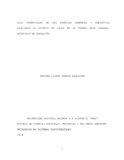| dc.contributor.advisor | Carvajal Agudelo, Blanca Ninfa | |
| dc.coverage.spatial | udr_-_cubará | spa |
| dc.creator | Moreno Rodríguez, Yenifer Liseth | |
| dc.date.accessioned | 2018-06-09T01:42:03Z | |
| dc.date.available | 2018-06-09T01:42:03Z | |
| dc.date.created | 2018-06-07 | |
| dc.identifier.uri | https://repository.unad.edu.co/handle/10596/18433 | |
| dc.description.abstract | Arauca es un departamento en el cual la mayoría de la población se localiza en las áreas rurales y las actividades agropecuarias son el sector más sobresaliente de la economía. La ganadería (bovina) doble propósito y el cultivo de alimentos como la yuca, el plátano, maíz, arroz y el cacao son los elementos productivos que más se denotan.
Con el fin de alcanzar los propósitos productivos y competitivos que, en cuanto al sector agropecuario, se proponen a escala nacional, regional y local, se hace necesario conocer y e implementar modelos agrícolas que, de manera alternativa a la agricultura industrial, permitan el desarrollo del sector en términos de sostenibilidad ambiental y social.
Actualmente se evidencia en el municipio de Arauquita y sus alrededores un amplio desconocimiento de las propiedades y usos potenciales de las especies asociadas al cultivo de cacao y por tradición se tiende a su desaprovechamiento al implementarse el método de tumba y quema al iniciar un nuevo cultivo. Aunado a esto, gran parte del territorio municipal y regional se caracteriza por la diversidad de especies arbóreas y arbustivas que pueden ser potenciales para implementar cultivos agroforestales o asociados.
En este orden de ideas, este proyecto se propone profundizar en cuanto al conocimiento de los usos potenciales de las especies arbóreas y arbustivas asociadas al cultivo de cacao, las técnicas de manejo, las asociaciones, sus propiedades, cuidados y ventajas productivas. En primer lugar, identificando las especies arbóreas y arbustivas asociadas al cultivo de cacao, caracterizándolas y evaluando sus condiciones generales, luego, realizando un diseño de siembra con sus respectivos aspectos técnicos, para finalmente calcular los costos y evaluar los beneficios y bondades del sistema.
Para esto se recurre, en primera instancia a la investigación bibliográfica y documental, posteriormente por medio de la observación, el trabajo de campo, el levantamiento de entrevistas en la vereda Bajo Caranal del municipio de Arauquita se plante la proyección y evaluación del modelo agroforestal en el cultivo de cacao. | spa |
| dc.format | pdf | spa |
| dc.format.mimetype | application/pdf | spa |
| dc.language.iso | spa | spa |
| dc.publisher | Universidad Nacional Abierta y a Distancia UNAD | spa |
| dc.title | Usos potenciales de las especies arbóreas y arbustivas asociadas al cultivo de cacao en la vereda Bajo Caranal, municipio de Arauquita. | spa |
| dc.type | Proyecto de investigación | spa |
| dc.subject.keywords | Cultivo de Cacao | spa |
| dc.subject.keywords | Sistemas Agroforestales | spa |
| dc.description.abstractenglish | Arauca is a department in which the majority of the population is located in rural areas and agricultural activities are the most outstanding sector of the economy. The cattle (bovine) double purpose and the culture of foods like the yucca, the banana, maize, rice and the cocoa are the productive elements that more are denoted. In order to achieve the productive and competitive purposes that, in the agricultural sector, are proposed at national, regional and local levels, it is necessary to know and implement agricultural models that, in an alternative way to industrial agriculture, allow the development of sector in terms of environmental and social sustainability. Currently, there is widespread ignorance in the municipality of Arauquita and its surroundings of the properties and potential uses of the species associated with the cultivation of cocoa, and traditionally it tends to be wasted when the tomb and burn method is implemented when a new crop is started. In addition to this, a large part of the municipal and regional territory is characterized by the diversity of arboreal and shrub species that may be potential to implement agroforestry or associated crops. In this order of ideas, this project intends to deepen in terms of knowledge of the potential uses of tree and shrub species associated with the cultivation of cocoa, management techniques, associations, their properties, care and productive advantages. First, identifying the arboreal and shrubby species associated with the cocoa crop, characterizing them and evaluating their general conditions, then, making a planting design with their respective technical aspects, to finally calculate the costs and evaluate the benefits and benefits of the system. To this end, bibliographic and documentary research will be used first, and later, through observation, fieldwork, interviews in the Bajo Caranal district of the municipality of Arauquita, the projection and evaluation of the agroforestry model will be considered. The cultivation of cocoa. | spa |
| dc.subject.category | Tecnología en Sistemas Agroforestales | spa |
| dc.rights.accesRights | info:eu-repo/semantics/openAccess | spa |
| dc.rights.acceso | Abierto (Texto Completo) | spa |















